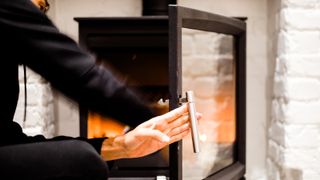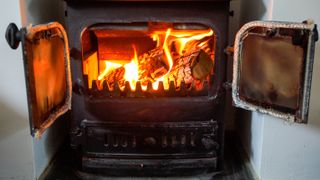How to clean log burner glass and get your stove winter ready
Knowing how to clean log burner glass properly will ensure your wood burning stove looks and performs at its best — we are here with all the best tips

Has the arrival of colder weather left you wondering how to clean log burner glass? Although it is best to clean the glass in a log burner shortly after it becomes sooty, it might only be now, when thoughts are turning to cosy nights in front of the fire, that you have decided to give the dirty glass some attention.
Log burning stoves make a beautiful addition to all kinds of homes and are an effective way of heating up a room fast — plus they add bags of character and charm to spaces both old and new.
That said, there is a certain amount of upkeep involved to ensure they work efficiently and retain their attractive appearance. Ordering and storing firewood, setting the fire and cleaning out ash and debris are all necessary maintenance jobs for owners of log burners — as is keeping the stove glass spotless.
Here, we give you the best ways to clean log burner glass to leave it crystal clear — and also explain the methods you should most certainly avoid.
How to clean log burner glass: Top five tips
Understanding how to maintain a log burning stove is absolutely vital both to ensure you can enjoy gazing at the flickering flames through sparkling clean glass, as well as to keep it running at peak performance.
“A bright, clean and steady flame is the goal when using a log burner," confirms Phil Wood at wood burning stove specialists Contura. "With a little TLC you can sit back and enjoy the fire knowing it’s working to its potential. Troubleshooting any problems early is the best way to prevent issues further down the line — get ahead of the cold weather by getting your wood burner in order now.”
But with so many tips, tricks and hacks out there, knowing the best methods to use can be confusing. We have sifted out the top ways to clean a stove so you can minimise the elbow grease and maximise time spent snuggled up enjoying your fire.

Why does log burner glass go black?
Before getting into methods for cleaning fire glass, it is useful to understand what causes the glass to turn black in the first place.
"Many modern log burners generally feature clean-burn air wash which naturally keeps the glass clean," explains Ced Wells at Charnwood. "However, when used incorrectly, soot may build up on the glass door, which can drastically reduce the view of the fire. The most common cause of this is when wood with a moisture content higher than 20% is burnt or if a burning log is touching the glass."
The wrong fuel or burning your fire in an inefficient way are surprisingly common mistakes, both of which result in an excess of smoke that will mean your stove glass will get dirty quicker.
"Seasoned timber refers to wood that has been left to dry for 12-18 months or more to achieve a moisture content that is below 20%," says Michael Coke, Biomass Products Development Manager for Stovax Heating Group. "Seasoned wood increases the efficiency of combustion, which means more heat is generated from each log. Burning dry wood on your stove will warm the room up faster and you’ll also find you need less logs.
"In contrast, burning green or wet wood takes much longer to produce usable heat. This is because much of the heat is lost burning off the excess water contained within the logs. Wet wood will result in poor quality combustion, increased smoke and the production of tars and creosotes that will block your chimney and blacken the glass of your wood burning stove."
It is also a good idea to use a stove thermometer as this will show that your stove is burning at the most efficient temperature — if your fire is not hot enough and is smouldering, the glass will blacken faster.
Finally, understanding how to light a log burner properly should help too.

1. Newspaper and wood ash are your best friends
There are so many good things to say about this method of cleaning a log burning stove. Firstly, it is cheap. Secondly, it is super effective and, thirdly, it is chemical free.
Before you begin, grab a soft cloth and wipe down the inside of the glass. Then scrunch up some newspaper into lightly packed balls, before dampening it ever so slightly and dipping it into the wood ashes (either those still in your stove or some you have retained when emptying your stove pan.)
Now scrub the glass with the newspaper, using a circular motion until the soot residue comes away. Periodically wiping the ash and dirt away with a clean damp cloth will help you see your progress.
2. Tackle it with oven or hob cleaner
Many oven and hob cleaners are suitable for cleaning the inside of stove glass — but do read the label to ensure the product is safe for use on glass.
Obviously most of these types of cleaners contain chemicals, some of which can be harmful if they come into contact with skin or are inhaled so take the proper precautions.
Take care too that you don't damage seals or external finishes with chemical cleaners — some can be very powerful.
3. Buy specialist log burner glass cleaner
It is possible to buy cleaning sprays and cream cleaners designed specifically for cleaning stoves.
A product such as HG's Stove Glass Cleaner, available from Amazon, is designed to dissolve soot, grease and tar and Stovax also make a couple of stove glass cleaners Again, do take care around rope seals.
4. Raid the food cupboard for bicarbonate of soda
Bicarbonate of soda is not just for baking (or volcanic science experiments) — it also makes a handy and cheap log burning stove cleaner. With its mildly abrasive texture and ability to dissolve organic compounds such as dirt and grease, it makes a great natural cleaning substance.
Try mixing bicarbonate of soda with a little water to form a thick paste before scrubbing your glass stove doors with it and wiping away the excess.
5. Finish with vinegar and water
After you have finished cleaning your log burning stove glass, whichever method you have chosen, buffing the whole surface up with a solution of equal parts vinegar and water can remove any remaining residue or cleaning products and leave the whole thing gleaming — you can also use it on the outside of your glass doors.
What is an airwash stove?
If you are after a new log burning stove that will resist the build up of sooty deposits, you might like to consider one with an airwash system.
These stoves use vents to draw in cool air before heating it and passing it over the inside of the glass — this can help keep the glass cleaner for longer.
Log burning cleaning methods to avoid
In order to ensure you don't cause damage to your log burner (or to yourself) there are also a few cleaning methods to steer well clear of:
- Never use sharp objects to try to scrape soot or residue from your log burner glass — paint scrapers, knives and similar can all damage and scratch the glass
- Be wary of using abrasive cleaners. Although some gentle solutions can be quite effective, some of the harsher products could severely scratch the surface of the glass
- Don't spray water or cleaner onto hot glass. It could cause it to shatter or crack
- Never try to clean a stove while it is still burning or when the glass remains hot to touch
Get the Homebuilding & Renovating Newsletter
Bring your dream home to life with expert advice, how to guides and design inspiration. Sign up for our newsletter and get two free tickets to a Homebuilding & Renovating Show near you.
Natasha was Homebuilding & Renovating’s Associate Content Editor and was a member of the Homebuilding team for over two decades. In her role on Homebuilding & Renovating she imparted her knowledge on a wide range of renovation topics, from window condensation to renovating bathrooms, to removing walls and adding an extension. She continues to write for Homebuilding on these topics, and more. An experienced journalist and renovation expert, she also writes for a number of other homes titles, including Homes & Gardens and Ideal Homes. Over the years Natasha has renovated and carried out a side extension to a Victorian terrace. She is currently living in the rural Edwardian cottage she renovated and extended on a largely DIY basis, living on site for the duration of the project.
